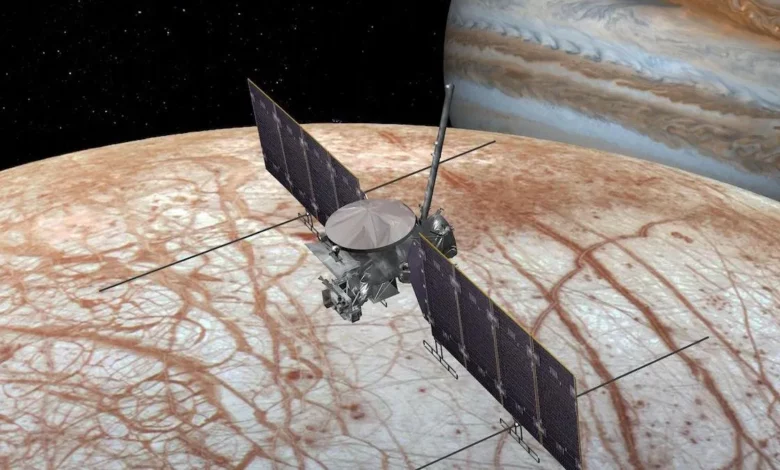
Europa, an ice marble and one of Jupiter’s 92 known moons, will be the destination of a NASA Europa Clipper mission launch in October. What does the probe primarily aim to accomplish? So that researchers can determine whether Europa is habitable.
The robotic explorer known as the NASA Europa Clipper appears to be in good shape for its cosmic mission. According to a press release from the agency on Tuesday,. All nine pieces of scientific equipment and a communications system have been placed at the Jet Propulsion Laboratory (JPL). Yet it is an entirely different matter.
Included in the technological cargo is equipment such as a mass spectrometer. That will determine the gas molecules’ mass-to-charge ratio on Europa. An analyzer for surface dust; and an image spectrometer. Those will map the organic molecules, salts, and ices on the moon by studying the interactions between light and matter.
Read Also: ‘Mind-Blowing’ Photos snapped by NASA James Webb Space Telescope
Europa Clipper Mission to Capture Stunning Views of Icy Moon and Seek Answers to Mysteries
The Europa Clipper also has cameras that, according to NASA, will capture both wide-angle and narrow-angle views of the moon’s ice surface. We can anticipate seeing some amazing color photographs that will give us a sense of what it could be like to be on a moon hundreds of millions of kilometers away from Earth.
This is fascinating for several reasons, not the least of which is the possibility that researchers may finally have the answers to some long-standing mysteries. Such as the possibility that the Juno mission, which has been investigating Jupiter, picked up on some recent activity in the area.
Speaking of which, Clipper is scheduled to reach the Jupiter system no earlier than 2030 due to that very long distance. Throughout its four-year orbit around the massive planet, the spacecraft will make 49 close flybys of Europa.
“The instruments work together hand-in-hand to answer our most pressing questions about Europa,” said Robert Pappalardo, the mission’s project scientist. “We will learn what makes Europa tick, from its core and rocky interior to its ocean and ice shell to its very thin atmosphere and the surrounding space environment.”
Read Also: Copernicus Grave: A Strange Story
Discovering Life on Jupiter’s Moon: The Search for Europa’s Secret Ocean
Since Europa is widely considered one of the solar system’s prime locations for the hunt for extraterrestrial life. This mission takes on an air of monumental proportions. It has all the necessary ingredients for a habitable planet, including a salty underground ocean, among many others.
Scientists are so intrigued by the idea of frozen moons with seas underneath. This idea pushed for the development of cryobots that can “burrow” under frozen crusts and help them thaw out. The James Webb Space Telescope discovered carbon in Europa’s subsurface sea last year.
Europa may also be releasing plumes of water vapor from its cold surface. That component is essential for the Europa Clipper. because it enables the spacecraft to possibly collect subsurface samples from the moon without ever touching down. (While it won’t touch down, Clipper is collecting information that might be useful for an eventual Europa landing mission.)
Read Also: Webb Reveals That Galaxy Mergers Are the Solution
Using State-of-the-Art Technology, the NASA Europa Clipper Mission Explores the Icy Moon Europa
So, in order to investigate that alluring, submerged ocean, the spaceship will have a few tricks up its sleeve. “A spectrograph will collect ultraviolet light to search for plumes and identify how the properties of the dynamic atmosphere change over time,” announces NASA, adding that the spacecraft will also include a magnetometer.
The announcement states that the information will be crucial. Especially for the understanding of the ocean because Europa’s movement through Jupiter’s potent magnetic field induces, or creates, the field. “Working in tandem with the magnetometer is an instrument that will analyze the plasma (charged particles) around Europa, which can distort magnetic fields.”
At the same time, a radar device will send out radio waves toward Europa’s surface and then observe how those waves reflect off of certain structures that may be on the frozen earth or even in the water. The distance to those landmarks may be determined by measuring the time it takes for the waves to return. You should now have a good idea of what it looks like under Europa’s icy surface. The crew has promised to install the antennas needed for this equipment on board the spacecraft later this year.
Europa Clipper’s crew has assembled several complementary pieces of equipment that will enhance the ship’s overall performance. They claim that the mission’s success hinges on the instruments’ ability to collaborate and provide the most comprehensive picture of the enticing, icy planet yet.
Europe”The science is better if we obtain the observations at the same time,” he said. “What we’re striving for is integration, so that at any point we are using all the instruments to study Europe at once, and there is no need to have to trade off among them.”
Read Also: Oldest Black Hole Ever Devours Galaxy Feasting From the Big Bang



